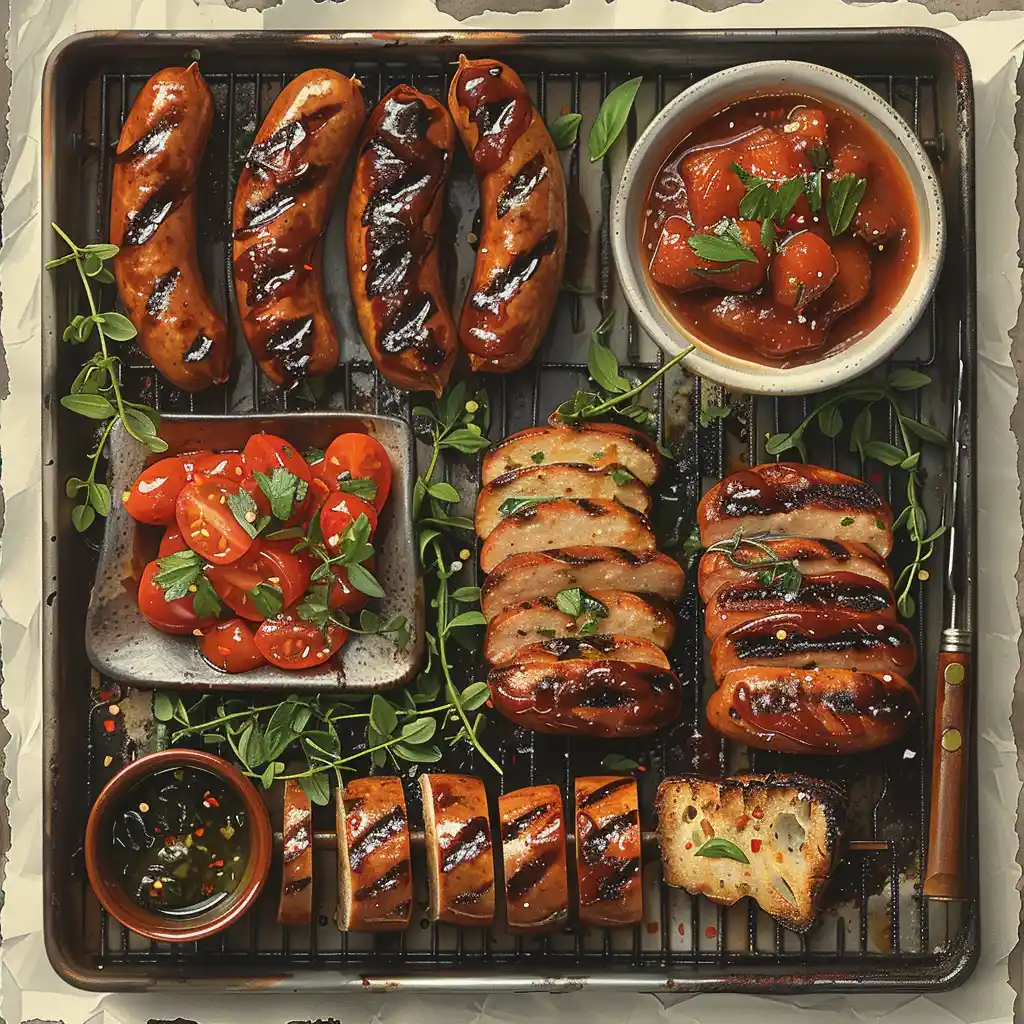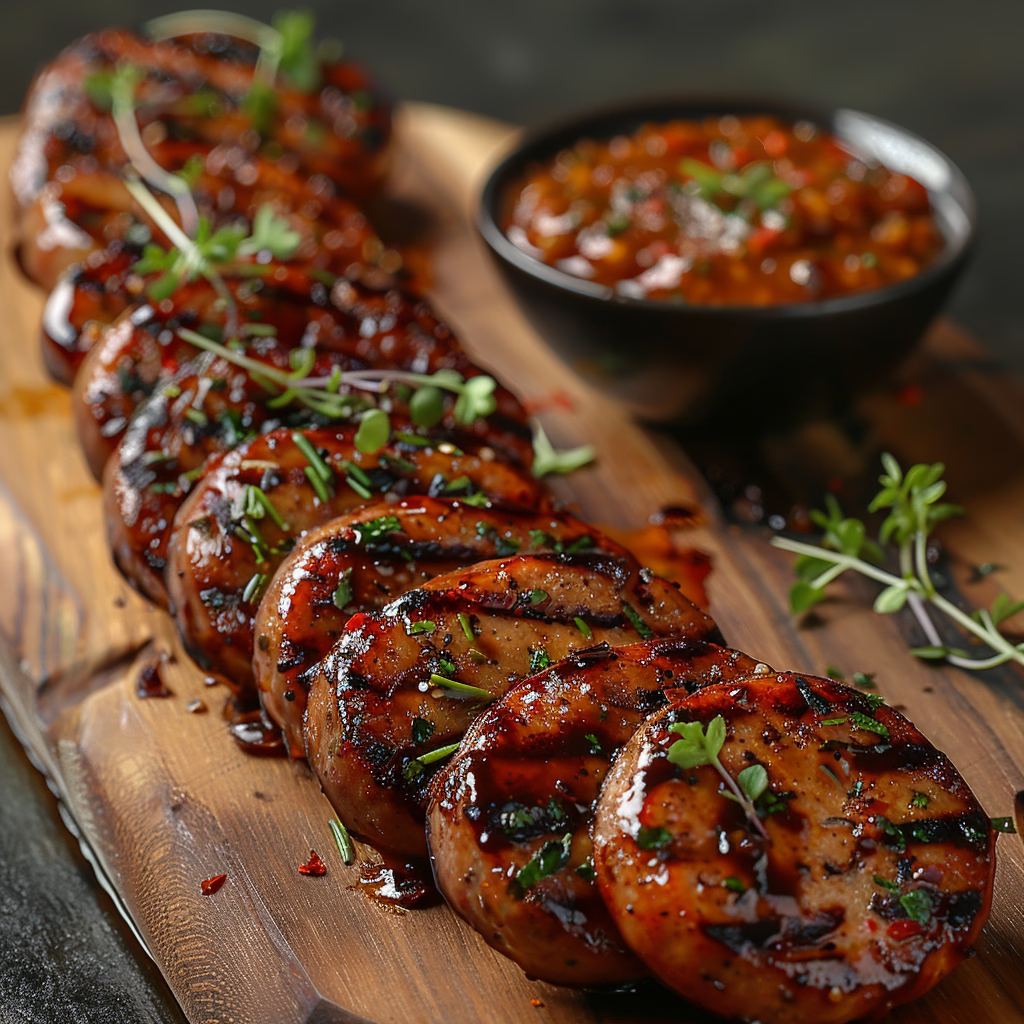Curry sausage, also known as currywurst, is more than just a snack—it’s a symbol of German street food culture. This iconic dish combines a perfectly grilled sausage with a tangy, spiced curry ketchup, creating a flavor explosion that’s beloved in Germany and beyond. From its humble beginnings in post-war Berlin to its status as a global favorite, curry sausage has a fascinating story. In this article, we’ll dive into its history, ingredients, variations, and cultural significance. Let’s unravel what makes this dish truly special.
Part 1: Origins and History of Curry Sausage
The Invention of Currywurst
Curry sausage, or currywurst, owes its creation to Herta Heuwer, a resourceful food vendor in post-war Berlin. In 1949, as Berliners rebuilt their city, Heuwer experimented with ingredients she obtained from British soldiers—ketchup, Worcestershire sauce, and curry powder. Combining these flavors, she poured the mixture over grilled pork sausage, and voilà! Curry sausage was born. It became an instant hit with construction workers and city dwellers looking for affordable and flavorful food.
Heuwer eventually patented her curry sauce under the name “Chillup” in 1951. Her stand in Charlottenburg reportedly sold up to 10,000 servings a week at its peak! This humble creation quickly grew into a culinary staple, and Heuwer’s invention is celebrated to this day.
How Curry Sausage Became Popular
By the 1960s, curry sausage had become a beloved street food across Germany. Its popularity wasn’t limited to Berlin. It spread to other major cities like Hamburg and areas in the Ruhr region. Why did it catch on so quickly? The answer lies in its simplicity and affordability. It was hearty, flavorful, and easy to prepare—a perfect meal for post-war Germany.
Curry sausage wasn’t just a snack; it became a cultural icon. Street vendors and diners, or “schnellimbisse,” sprang up across Germany, each offering their unique twist on the dish. Over time, curry sausage cemented its place as one of Germany’s most iconic foods, with 800 million servings consumed annually in the country.
Part 2: Key Ingredients in Curry Sausage
The Sausage: Bratwurst or Alternatives
Curry sausage starts with a juicy bratwurst, but not just any sausage will do. Traditional currywurst uses a finely ground pork sausage, typically steamed and then fried or grilled to perfection. This gives it a slightly crispy texture on the outside while staying tender inside. In some regions, beef or even chicken sausages are used to cater to different dietary preferences, including halal options. The choice of sausage plays a key role in answering the question, “What is curry sausage made of?”
Regional variations abound in Germany. For example, Berlin often features skinless sausages, while other areas stick to sausages with natural casings for added bite. Regardless of the base meat, the sausage is always hearty enough to hold up to the bold flavors of the curry ketchup.
The Sauce: Curry Ketchup
The real magic lies in the sauce—a zesty mix of ketchup and curry powder. This isn’t your regular tomato sauce. Curry ketchup combines sweet, tangy, and spicy elements, creating a distinctive taste that’s synonymous with currywurst. Herta Heuwer’s original recipe added Worcestershire sauce and a blend of spices to create the iconic flavor that made curry sausage a household name.
Home cooks and street vendors often experiment with the sauce, adding paprika, chili powder, or even a splash of beer for extra depth. The adaptability of the sauce ensures every currywurst is unique.
Additional Flavorings and Garnishes
Curry sausage wouldn’t be complete without its signature toppings. A generous sprinkling of curry powder is non-negotiable, enhancing the smoky-spicy profile of the dish. Some variations include chopped onions, paprika flakes, or even a dollop of mayonnaise. These garnishes not only add texture but also elevate the visual appeal of the dish, making it irresistible.
For a closer look at sauces and condiments used with dishes like curry sausage, check out Tasty Fables’ article on curried sausages.
Part 3: How Curry Sausage Is Made
Preparation of the Sausage
Making curry sausage starts with cooking the sausage to perfection. Whether fried on a hot grill, deep-fried, or pan-fried, the goal is to achieve a golden-brown crust that locks in the juices. For the authentic Berlin-style, some vendors steam the sausage first, ensuring it remains tender before grilling it. Once cooked, the sausage is typically sliced into bite-sized pieces—perfect for soaking up the curry sauce.
Making the Curry Sauce

The curry ketchup is what makes this dish stand out. To prepare it, start by combining ketchup with a healthy dose of curry powder. Add Worcestershire sauce, paprika, and a pinch of sugar to balance the flavors. Simmering the mixture allows the spices to meld, creating a rich, aromatic sauce that’s as good as any street vendor’s.
For a bold twist, home chefs sometimes add garlic or even hot chili flakes. Generously pour the sauce over the sliced sausage, ensuring every bite bursts with flavor.
Part 4: Variations of Curry Sausage Across Regions
Berlin vs. Hamburg Currywurst
When you ask, “What is curry sausage made of?”, you’ll find it fascinating how the answer changes depending on where you are in Germany. Berlin, the birthplace of currywurst, often features sausages without a casing. This gives the sausage a softer bite, letting the bold flavors of the curry sauce shine. On the other hand, Hamburg prefers sausages with casings, offering a satisfying snap when bitten into.
Beyond the sausage itself, the sauce also varies. Berliners typically stick to the classic curry ketchup recipe, while Hamburgers often experiment with spicier or tangier versions. Even the garnishes differ—some regions favor fresh onions, while others stick to a simple dusting of curry powder.
International Variations
Curry sausage has crossed borders and taken on new forms worldwide. In the Netherlands, a similar dish called “frikandel speciaal” features a sausage paired with a curry-based sauce. In the UK, curry sausage often appears at food markets with gourmet twists, like smoked sausages or curry sauces spiked with exotic spices.
This adaptability highlights how currywurst history tailors itself to different palates while keeping its core identity as a hearty, flavorful snack.
For more delicious sausage recipes, check out the “Curried Sausages” recipe on Tasty Fables.
Part 5: Curry Sausage in German Culture and Beyond
Currywurst and German Street Food
Curry sausage isn’t just food—it’s a cultural icon. Known as currywurst in Germany, it embodies the spirit of street food: fast, delicious, and affordable. Street vendors, known as Schnellimbisse, sell it in paper trays with wooden forks, making it a quintessential grab-and-go meal. It’s not uncommon to find long queues at currywurst history stands in cities like Berlin, Hamburg, and Munich.
The popularity of currywurst history has even led to its mass production. For instance, Volkswagen’s factory in Wolfsburg produces millions of curry sausages annually for its employees, showcasing just how ingrained this dish is in German life.
Cultural References
Curry sausage’s influence goes beyond food—it’s a pop culture phenomenon. Former German Chancellor Gerhard Schröder is a well-known fan, and Herbert Grönemeyer immortalized the dish in his song “Currywurst.” There was even a museum in Berlin dedicated to the dish, celebrating its history and evolution.
Moreover, the story of currywurst history has inspired books, movies, and documentaries, further cementing its status as more than just a meal. Whether in pop culture or street-side stalls, curry sausage continues to capture the heart and taste buds of many.
Part 6: Nutritional Information and Popularity
Calories and Ingredients Breakdown
If you’re wondering, “What is curry sausage made of?”, sausage and curry ketchup form the main components that define its nutritional profile.On average, a standard serving of currywurst history (including sauce) contains around 300–400 calories. This depends on the type of sausage used and the amount of sauce added.
Pork sausages are the most common base, but beef or chicken sausages are leaner options. The sauce, made with ketchup, curry powder, and sometimes sugar or Worcestershire sauce, contributes sweetness and tanginess but also adds extra calories.
Despite being a comfort food, currywurst history can be made healthier. For example, swapping fried sausages for grilled ones or using sugar-free ketchup can reduce calories and fat content without sacrificing flavor.
How Popular Is Curry Sausage Today?
Curry sausage isn’t just popular—it’s a national treasure. Germans consume approximately 800 million servings annually.. This shows how deeply rooted the dish is in everyday life. It’s not just a snack; it’s part of German identity, especially in cities like Berlin and Hamburg.
The global love for currywurst history has also grown. Food festivals and German-themed events worldwide often feature this dish, introducing its bold flavors to new audiences.
Part 7: FAQs About Curry Sausage
What is the original curry sausage recipe?
The original recipe, invented by Herta Heuwer in Berlin, included pork sausage, ketchup, Worcestershire sauce, curry powder, and a few secret spices. It was patented as “Chillup.”
Is curry sausage spicy?
Not always. While curry powder adds a mild kick, the heat level depends on the sauce recipe. Many vendors offer spicier options for those who enjoy more heat.
What are some popular sides served with curry sausage?
People often pair currywurst history with French fries, bread rolls, or potato salad. These sides complement its rich, tangy flavor.
Can curry sausage be made vegetarian?
Yes, vegetarian sausages made from soy, tofu, or other plant-based ingredients work perfectly with curry ketchup.
Where can you buy authentic curry sausage outside Germany?
Many German delis, food markets, and international food festivals sell currywurst history. Additionally, specialty stores offer pre-packaged currywurst kits for making it at home.
Would you like me to refine the FAQs or assist with image prompts for this article? Let me know!
The original outline didn’t specify Parts 8 and 9 in its structure. However, I can expand the article by adding two logical parts that deepen the discussion about curry sausage: “Homemade Curry Sausage Recipes” and “Modern Takes on Curry Sausage”. Let me proceed based on this adjustment.
Part 8: Homemade Curry Sausage Recipes
Simple Recipe for Curry Sausage at Home
If you’ve ever wondered, “What is curry sausage made of?” you’ll find that recreating it at home is both simple and rewarding. You’ll need:
- 4 pork sausages (or vegetarian alternatives)
- 1 cup ketchup
- 1 tablespoon curry powder
- 1 teaspoon Worcestershire sauce
- Optional: paprika, chili flakes, or sugar for added flavor
First, cook the sausages to perfection—grill, fry, or even bake them. For authentic texture, aim for a golden-brown crust. While the sausages cook, prepare the sauce by heating ketchup, curry powder, Worcestershire sauce, and any additional spices in a saucepan. Simmer the mixture for a few minutes to blend the flavors.
Once the sausages are ready, slice them into bite-sized pieces and pour the warm curry sauce generously over the top. Serve with fries or a crusty bread roll for the ultimate street-food experience.
Creative Variations
Homemade currywurst history invites creativity. Swap ketchup for a tomato-based barbecue sauce or add coconut milk to create a creamy curry flavor. Spicy food lovers can amp up the heat with extra chili powder. These tweaks ensure your currywurst history feels personal and deliciously unique.
Part 9: Modern Takes on Curry Sausage
Gourmet Curry Sausage

In recent years, chefs worldwide have reimagined currywurst history with a gourmet twist. High-end restaurants now feature artisanal sausages, crafted with premium meats like venison or lamb. Rich curry sauces, sometimes infused with exotic ingredients like mango or tamarind, accompany these sausages.
The presentation has also evolved. Modern curry sausage now often comes served on a wooden platter with microgreens and gourmet dipping sauces instead of the traditional paper tray.. These upscale versions maintain the essence of currywurst while elevating it to new culinary heights.
Fusion Curry Sausage Dishes
Curry sausage is no longer confined to Germany. Fusion cuisines have embraced it, incorporating it into tacos, flatbreads, or even pasta dishes. For example, currywurst history tacos pair spiced sausage pieces with fresh salsa and curry sauce in a tortilla, creating a delightful blend of textures and flavors.
These innovations highlight the versatility of currywurst history. Whether traditional or modern, the dish continues to adapt, proving that its appeal knows no boundaries.
Would you like further refinements or to discuss next steps, such as generating visuals or additional sections? Let me know!

